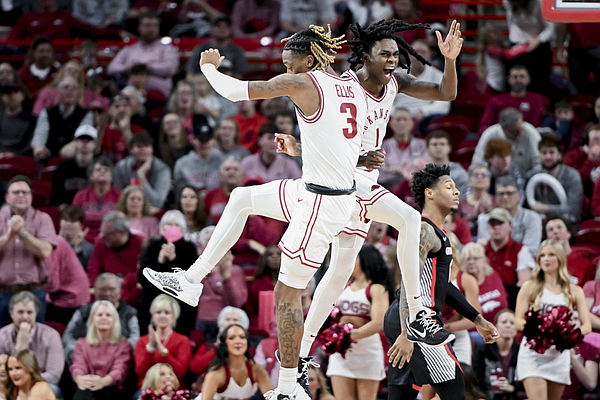FAYETTEVILLE — El Ellis’ return to the starting lineup proved productive for the Arkansas Razorbacks in Saturday’s 78-75 win over Georgia at Walton Arena.
The senior guard scored 15 points on 6-of-11 shooting, went 3 of 6 from three-point range and had 5 rebounds and 3 assists.
Ellis had not played at all in the previous two games before making his 12th start of the season. The transfer from Louisville scored 10 of his points in the second half while making 4 of 6 shots with a pair of three-pointers.
“I’m in the gym every day,” Ellis said on the Razorback Sports Network. “Whether I play or not, I’ll be ready. Tonight my number was called and I was ready to play and I wanted to play.
“I really feel like I can help this team. I’m just so happy we got that win and it’s so good to be out there.”
Arkansas Coach Eric Musselman discussed why Ellis made the starting lineup.
“I thought his practice habits were really good,” Musselman said. “With no mid-week game, we had a lot of time to adjust a lot of different things. I thought he was extremely focused, and so he got the start tonight.
“We’re still trying to search. Now we have nine guaranteed games left and we’re still trying to search. Based on matchups, we might have different lineups. That just might be who we are. It’s not what we’ve always done.”
Zone vibes
Georgia got good mileage out of a 1-3-1 trapping zone in the second half, forcing the Razorbacks into late shot clocks on several possessions and a spate of turnovers.
“Yeah, we were hopeful, we were optimistic that it could change the outcome of the game,” said Georgia Coach Mike White, who mentioned the Bulldogs ran the 1-3-1 some in a loss at Mississippi State on Wednesday.
After falling behind 47-35, Georgia ran the trapping zone much of the rest of the way to narrow the gap.
“It just slowed them down a little bit,” White said. “They’re such a high-powered offense and they’ve got several guys that can pass, dribble, shoot, space you and make plays off the bounce. I thought it could potentially decrease our fouling amount.”
The Razorbacks were able to get some penetration at times against the zone with Tramon Mark hitting some jumpers, and also drew some fouls. Davonte Davis made a key pass for a Makhi Mitchell layup for a 74-72 Arkansas lead with 54 seconds remaining.
“I thought we did a good job against [the] 1-3-1 defense, scoring 44 points in the second half,” Arkansas Coach Eric Musselman said. “They’re a good team, they’re a gritty team.”
Held down
Arkansas held Georgia’s leading scorer Jabri Abdur-Rahim to 2-of-6 shooting and 4 points after limiting him to 1-of 8-shooting and 5 points in the Bulldogs’ 76-66 win on Jan. 10.
That made the senior shooting guard, who averages 13.2 points per game, a combined 3 of 14 for 9 points against Arkansas.
“You’re going to have nights where you shoot it well and nights where you don’t shoot it well,” Georgia Coach Mike White said regarding Abdur-Rahim and Noah Thomasson. “Arkansas did a good job of defending those two guys. We had other guys step up offensively. I thought Silas [Demary] and Justin [Hill] were really good.”
Thomasson scored 4 points on 2-of-8 shooting.
Spin cycle
Jalen Graham put on another display with a series of spin moves, hooks, scoops and one-handed shots.
The 6-10 senior did almost all his damage in the first half by hitting 4 of 6 shots for 10 points. Graham finished 4 of 7 with 11 points while hitting 3 of 6 free throws.
Arc stories
Georgia missed its first 11 three-point shots in the first half, including a stretch of 6 in a stretch of 3 minutes late in the half in which Arkansas extended its lead from 22-20 to 30-20.
The streak ended when Silas Demary hit a three-pointer from the right corner on a pass from 7-footer Russel Tchewa at the 2:20 mark to draw the Bulldogs within 30-25.
4-miss trip
The Razorbacks missed four consecutive free throws on one trip while holding a 55-53 lead.
The free-throw problems started with two misses by Makhi Mitchell at the 7:43 mark. Mitchell’s second miss caromed over the block on the left side and Keyon Menifield chased it down while going out of bounds and bounced it off Jalen Deloach’s thigh and out of bounds.
A few seconds later, Tramon Mark was fouled and missed both of his free throws. Georgia scored at the other end for a 55-55 tie and the teams were never separated by more than five points the rest of the game.
Stepping out
Arkansas guard Keyon Menifield stepped out of bounds three times in the second half as part of his five-turnover game.
Twice a Georgia big man cut off Menifield’s drives on the left baseline and bumped him to the end line to step out of bounds.
Later, with the game tied 59-59, Menifield caught a pass on the right wing but had a foot on the sideline for a turnover.
Return of Devo
Guard Davonte Davis was the Hogs’ sixth man, checking in at the 17:23 mark for Jeremiah Davenport.
Davis, a senior from Jacksonville who had missed the previous three games while taking a break from the team, was greeted with a warm reception from the Walton Arena crowd.
Davis was the first player to hit a three-point shot in the game, with his long-distance shot on the right wing on a pass from El Ellis to tie the game at 15-15 with 10:12 left in the half.
Davis finished with 4 points on 1-of-1 shooting while also hitting 1 of 2 free throws.
Saturday’s all right
The Razorbacks won a Saturday conference game for the first time after starting 0-5.
Arkansas won on a Saturday for the first time since a 106-90 decision over North Carolina-Wilmington on Dec. 30.
The Hogs improved to 3-6 on Saturdays this season.
In the house
Two Razorback greats, including one of the famous “Triplets,” were among those in attendance.
Sidney Moncrief, a Little Rock native and member of the College Basketball and Naismith Memorial halls of fame, was introduced just prior to tipoff.
Joe Kleine, an Arkansas Hall of Honor member and long-time NBA standout, served as the color analyst on the SEC Network broadcast.
Both Moncrief and Kleine are members of the Arkansas Sports Hall of Fame.
































